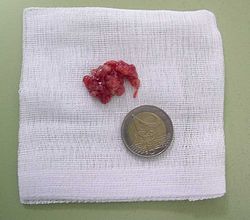Adenotomy
Under adenoidectomy refers to the surgical removal of the adenoids , d. H. the enlarged pharyngeal tonsils (tonsils).
Operation indication
Enlarged tonsils typically appear in childhood, so adenotomy is almost exclusively performed in children.
Adenoids lead u. a. about a relocation of the Eustachian tube (Tuba auditiva) to a ventilation disorder of the middle ear . This can lead to hearing impairment due to a tympanic effusion , frequent otitis media and, as a result, delayed language acquisition by the children concerned.
In addition, nasal breathing can be severely impeded, which manifests itself in snoring of the children and causes a higher frequency of infections. In contrast to the palatine tonsils, the pharynx can grow back and must therefore be removed again from time to time.
Disadvantages of adenotomy on the immune defense are not known. That is why, in contrast to the palatine tonsils, the tonsils are operated on even in small children; most operations are necessary between the ages of 2 and 6.
Performing the operation
The operative procedure was introduced by Hans Wilhelm Meyer .
The operation is usually carried out on an outpatient basis and under anesthesia with the airways secured via a ventilation tube (endotracheal tube or laryngeal mask) . The child lies on its back, the head is a little lower. After inserting a mouth gag , a small tube is passed in over the nose and over the mouth again, so that the soft palate is slightly gathered. Now you can look at the pharynx with a warmed mirror and remove it with a special instrument, the so-called Beckmann ring knife. Usually it is enough to stop bleeding by pressing a gauze pad over the ablated site for a few minutes . The small tube and mouth gag are removed and the anesthesiologist directs the anesthesia. The operation time is usually ten to twenty minutes. The adenotomy should be performed at the earliest in the 2nd or 3rd year of life because the (overall, rare) risk of anesthesia decreases with increasing age.
Since fluid is often present in the middle ear, as described above, an incision of the eardrum ( paracentesis ) and a tympanic tube insertion (tympanic drainage ) are often performed during the same anesthesia . In some cases the tonsils are removed ( tonsillectomy ), but this should only be done if tonsillitis is common.
Risks
The operation is one of the lowest risk operations in the ENT area. Possible general surgical risks are bleeding; slight, but also very intense, secondary bleeding. Intensive secondary bleeding must be treated under anesthesia, whereby a so-called Bellocq tamponade is usually necessary. Special surgical risks are tooth damage from the intubation spatula or mouth spreader , especially if teeth are loose; Damage to the Eustachian tube with possibly permanent ventilation disorders of the middle ear, combined with tympanic effusions. It may happen that fluid leaks through the nose while drinking temporarily after the operation. This is because the children did not have to pull their soft palate back to seal the nose when drinking because of the enlarged tonsils and have to learn to do so first. Sometimes there is also an open nose (Rhinophonia aperta), which disappears over time.
Demarcation
Colloquially, one often speaks of the removal of "polyps" or "growths". The pharynx has nothing to do with real nasal polyps .
